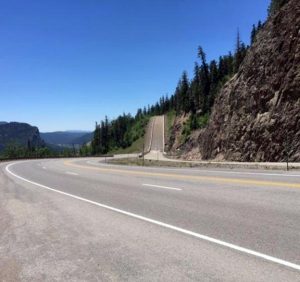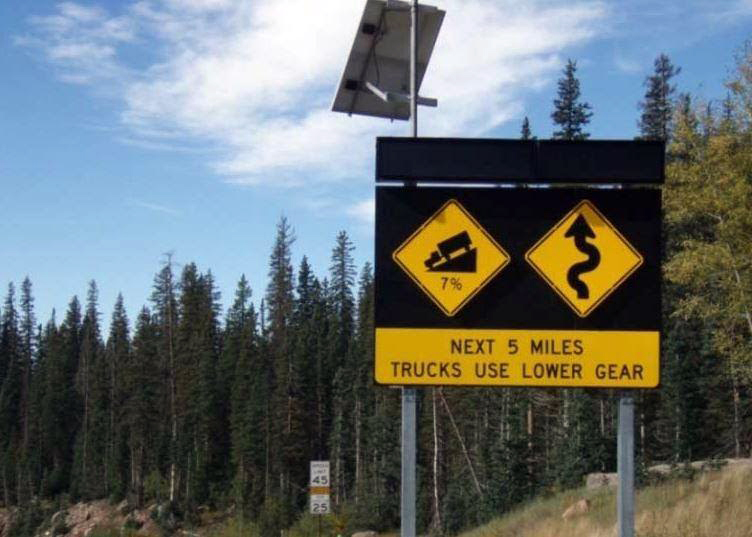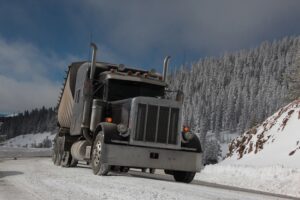DENVER — Traveling through the Rocky Mountains of Colorado can offer challenging, and often dangerous, conditions for truckers, especially during winter snowstorms. The Colorado Department of Transportation (CDOT) warns tractor-trailer drivers to use extreme caution when traversing mountain passes, such as the Wolf Creek Pass stretch of U.S. 160 in southwest Colorado.
“The number of crashes over the years underscores the need to slow down over this mountain pass,” said Colorado State Patrol Capt. Adrian Driscoll. “From 2015 to 2019, there have been 47 semi-truck crashes on the west side of Wolf Creek Pass. Three of those crashes resulted in needless fatalities.”
To help keep truck drivers safe on these mountain roads, CDOT has teamed up with the Colorado State Patrol to conduct safety checks of commercial motor vehicles at the summit of Wolf Creek Pass on U.S. 160 during October. The safety checks will involve interviewing the commercial drivers, informing them of the locations of tight turns on the pass, and educating them about the importance of downshifting and maintaining a low speed when indicated by signage or necessary due to inclement conditions. Printed materials will be available in both English and Spanish.
“Stopping CMVs and talking with drivers has proven successful,” Driscoll said. “Past safety checks have coincided with construction projects on the pass — letting drivers know what they are in for, coming down the pass can prevent a potential crash, so we’re going to pick those efforts up again.”
A 2016 road safety audit provided CDOT with information that helped the department identify several recent safety enhancements on the pass that improve driver safety and behavior. These improvements included overhead electronic signs, enhanced large warning signs, and increasing the length of the concrete barrier at the scenic overlook. The audit also showed that a majority of the crashes occurred at the switchback curve located near the Wolf Creek scenic lookout area.
“This pass can be very deceiving to the traveling public,” said George Hudran, CDOT’s maintenance foreman for Wolf Creek Pass.
“The highway is wide, with three and four lanes along some stretches, and ample shoulders. Many truck drivers are fooled by these road features, only to find themselves out of control once they’ve made it half way down the pass,” Hudran said. “The drivers of commercial vehicles and heavy trucks should always take time to familiarize themselves with their routes. Knowledge and understanding of our state roadways is extremely important when traversing over mountain passes, especially one like Wolf Creek Pass.”
The posted speed limit for commercial trucks when traveling westbound (downhill) from the summit of Wolf Creek Pass, at Wolf Creek Ski area, is 25 mph (45 mph for passenger cars). The approximately 8-mile stretch has a 7% downhill grade, with a hairpin turn 6.5 miles from the summit. In addition, commercial drivers should be alert for passenger vehicles attempting to enter or exit the roadway from the ski area, a public scenic outlook and forest roads along the downhill slope.

CDOT advises truck drivers to inspect their brakes at the summit of the pass, before beginning the descent. There is a wide shoulder area available for use by both westbound and eastbound motorists. In the event a trucker loses control on the way down, there are two runaway escape ramps, one at milepost 162.5 (about 4.5 miles from the summit) and another “last-chance” ramp at milepost 161 (about 6 miles from the top).
“If a truck driver has lost control, there should never be a hesitation to use the runaway ramps,” Driscoll emphasized. “If a truck’s brakes fail due to overheating or excessive use going downhill, runaway ramps are the only way the truck will be able to stop.”
If a driver is forced to use a runaway ramp:
- Maneuver the trucks into the far-right lane before approaching upgrade ramps.
- As the truck approaches the runaway ramp, steer straight and try to keep the wheels aligned.
- Ramps are narrow. Attempt to stay in the center of the ramp to avoid any risk of rolling over.
- Once the truck is stopped, call 911 to report the incident, even if there are no injuries associated with the episode.
“Truckers should also consider the load they are hauling. Goods carried on the trucks and in the trailers are essentially the drivers’ income; there should be great concern protecting that commodity,” Driscoll said. “There may be monetary consequences for using a runaway ramp — potential fees associated with a tow company’s removal of the truck from the ramp or perhaps even a law enforcement fine. But not using the ramp can result in the ultimate cost: the irreplaceable life of a driver or the lives of those they share the road with.”
Even the most experienced drivers should practice the utmost caution and safe driving practices to keep control of their vehicles, CDOT warned, offering the following advice:
- Check brakes before descending the pass.
- Maintain a low speed, in low gear. Use flashers to warn other vehicles of the truck’s low speed.
- Do not “ride” the truck’s brakes. This will cause overheating and possible loss of the brake system.
- Jake Brakes (or compression brakes) can be a useful braking mechanism to help control the speed of a heavy truck. However, the best practice is to remain in low gears to avoid overheating.
- Keep brakes cool by pulling into brake stations or onto the shoulder of the road, if a safe spot can be located.
Other mountain passes in southwest and south-central Colorado include the Red Mountain, Molas and Coal Bank passes on U.S. 500; Lizard Head Pass on State Highway 145; La Manga-Cumbres Pass on State Highway 17; and Monarch Pass on U.S. 50.
For more information about road and travel conditions and commercial-vehicle regulations in Colorado, visit the CDOT website.
The Trucker News Staff produces engaging content for not only TheTrucker.com, but also The Trucker Newspaper, which has been serving the trucking industry for more than 30 years. With a focus on drivers, the Trucker News Staff aims to provide relevant, objective content pertaining to the trucking segment of the transportation industry. The Trucker News Staff is based in Little Rock, Arkansas.














